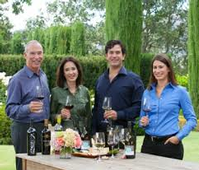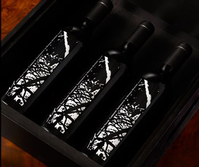|
|
 |
.jpg)
Mondavi. It’s a legendary name. In the world of wine it conjures memories of visionary thinkers, charismatic leaders, bitter family strife, ugly separations and rising from the ashes…not just once. Twice. I wasn’t yet involved with wine when Robert and Michael were forced out of the family business at Charles Krug Winery. The result of that separation was the Robert Mondavi Winery. Robert went on to put the Napa Valley and his winery on the international wine map (among the elite, really), employing the talents of such winemakers as Warren Winiarski, Mike Grgich and Zelma Long. I had the honor of meeting him many times and writing about many of his innovative ideas.
I was also around to witness from afar the meltdown at Robert Mondavi Winery that split family members once again, though perhaps this time with some financial compensation the sale to Constellation Brands. Robert’s son Tim and daughter, Marcia Mondavi Borger, along with their children, started the Continuum Estate. Son Michael and his family started wine ventures of their own.
I recently met with Michael Mondavi, co-founder with his father of the Robert Mondavi Winery in 1966 and currently head of Michael Mondavi Family Estates. The family business includes his wife Isabel, son Rob Jr. and daughter Dina. The first company they created in 2004, after Michael left Robert Mondavi Winery, was Folio Fine Wine Partners, an import and marketing company. In 2006, the Michael Mondavi Family Estate was established. Notice that in neither venture is the name Mondavi paired  with the word wine or winery, apparently a condition of the sale of the Robert Mondavi Winery, which at some point Michael was able to renegotiate for his brand. with the word wine or winery, apparently a condition of the sale of the Robert Mondavi Winery, which at some point Michael was able to renegotiate for his brand.
It had been at least a decade since I had last seen Michael Mondavi. He is now 70, and though he apparently doesn’t run regularly anymore, he is still trim and has the energy and enthusiasm that seems to be a family trait. I asked him what it was like for him during the unfolding of events preceding the change of ownership of the Robert Mondavi Winery. “I realized for the first time in my life that I wasn’t enjoying going work.” He bemoaned the fact that decisions were made by financial managers to satisfy shareholders on a quarterly basis, with no long term vision. By contrast, he recounted visiting the various Frescobaldi estates, a Folio import, along with a Frescobaldi family member, when he noticing a newly planted grove of trees that wouldn’t reach maturity for many, many years. When asked about it, his host explained that the trees were planted for the benefit of grandchildren.
The main purpose of the meeting was to introduce me to Mondavi’s personal project, M, but we also tasted wines from two other family brands, Isabel Mondavi and Emblem. The first wine he poured was the Isabel Mondavi Napa Valley, Cabernet Sauvignon, Deep Rose 2012 ($20). It’s a deeply colored wine made primarily from Cabernet Sauvignon with some Petite Verdot and very small amounts of Petite Sirah and Cabernet Franc. Isabel is Mondavi’s wife, and his son, Rob Mondavi, Jr. is the winemaker. The style for the Isabel wines is elegant, with the exception of the rosé, which is strikingly intense.
Apparently, Isabel asked Rob to make a rosé in addition to the Chardonnay and Pinot Noir, a project he was not particularly excited about. However, some time later he brought a rosé to his mother for her approval. When she said she liked the wine, she was told that that was a good thing--since he had produced several hundred cases. This he accomplished by bleeding off a small portion of the fermenting juice of recently harvested red grapes. After the wine was poured for us, Mondavi spooned several ice cubes into our glasses, which is a fun way to enjoy the wine. It has enough body and intense black cherry and strawberry fruit to handle the ice. My favorite of the Isabel wines was the Carneros Estate Pinot Noir 2010 ($40), on account of its lovely balance of savory cherry fruit with zesty acidity.
We also tasted two Emblem wines, which are made entirely from Cabernet Sauvignon. The Emblem, Napa Valley 2010 ($35) is made from a blend of grapes from the hillside Oso Vineyard as well as valley floor grapes, and is a plush, easy drinking wine. The Emblem, Napa Valley, Oso Vineyard 2010 ($50) comes from their ten-acre vineyard between Sugarloaf and Howell Mountains. It shows the tautness of Napa hillside grown fruit with ripe black fruit with vanilla and chocolate notes held tightly by sleek tannins.
Michael’s wine is M ($200). It marks his return to winemaking, and it harkens back to the style of earlier times in the Napa Valley. Yes, he was the winemaker at Robert Mondavi Winery from its beginning until 1974, when he took on tasks more closely related to business and marketing.
The bottle is quite dramatic. The image on the front designed by former Gucci designer, Karen Joyce, is a graphic interpretation of the soil and vine roots of the Animo Vineyard. It’s easier to understand when viewed  with the bottle on its side. Reportedly, Mondavi has doused more than one tablecloth with his signature wine when he has forgotten to recork the opened wine before laying it down to discuss the artwork. with the bottle on its side. Reportedly, Mondavi has doused more than one tablecloth with his signature wine when he has forgotten to recork the opened wine before laying it down to discuss the artwork.
M is grown in the 15 acre vineyard called Animo (Italian for “soul”), sitting at 1350 feet in the Foss Valley of Atlas Peak. Mondavi planted the vineyard in 1998, but did not release a wine until 2005, because the grapes were not at a maturity level for the style he wanted. He is still working on getting the balance he wants. He poured the inaugural 2005, the 2007 and the 2009 to illustrate the evolution of that balance. The 2005 and 2007 are 100 percent Cabernet Sauvignon. The 2009 has a small percentage of Petit Verdot, which he thinks he will continue to keep in the blend.
All three of these wines show a departure in style from many of the big, blustery Napa cabs of the past several years. They display a family resemblance marked by elegant and complex fruit flavors of black currant, berries and black plum, layered with vanilla and dark chocolate. The biggest difference among the wines--aside from age--was the balance, which for Mondavi is the most important characteristic of M. The 2005 finished hot and the 2007 had noticeably chewy tannins. The 2009 must be closer to his goal, because it was seamless. That lovely hillside fruit has a floral note not found in the 2005 or 2007, due to the Petit Verdot. The tension between fruit, acidity and alcohol makes the wine quite enjoyable now, but promises harmonious longevity as well.
It was good to see the fruits of a family working together. Here’s wishing a little less drama for the current and future generations of the Mondavi family, and a lot more great wine.
|
 |
|